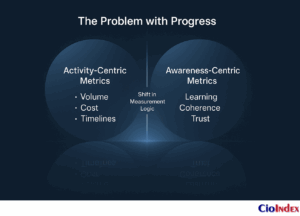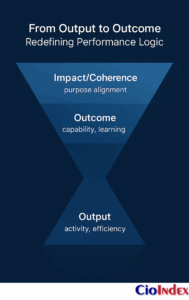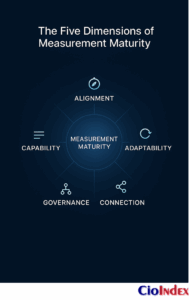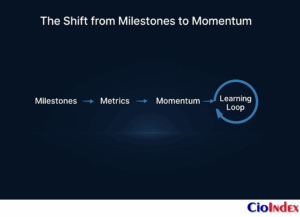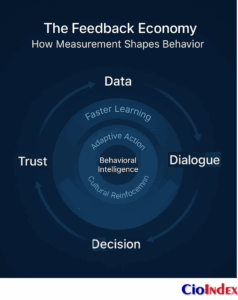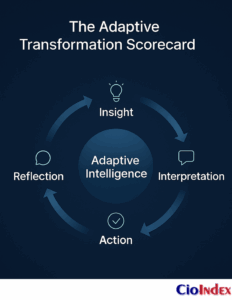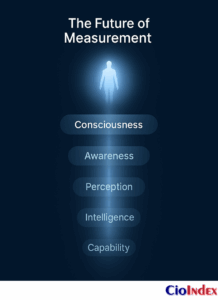The Measurement Dilemma: When Progress Outpaces Proof
Digital transformation has redefined how enterprises operate, but not how they measure themselves. The systems have evolved; the scorecards have not. Organizations now operate with intelligent infrastructure yet still evaluate progress through industrial logic — counting efficiency instead of adaptability, milestones instead of momentum.
This is where most transformations lose coherence. Metrics continue to describe what the enterprise does, not how it learns. Dashboards glow with data about implementation — adoption rates, cost savings, automation coverage — yet remain silent on the one variable that defines endurance: the organization’s capacity to evolve. Progress is recorded in numbers but rarely reflected in intelligence.
The issue is not absence of measurement but misalignment of meaning. Legacy performance models were built for stable systems: they reward completion, compliance, and control. Digital transformation, by contrast, creates living systems that thrive on iteration and feedback. Measuring them through static KPIs is like assessing a heartbeat by its stillness.
Research consistently reflects this mismatch. McKinsey’s 2023 survey found that fewer than 30 percent of transformations meet their objectives, not due to technical deficiency but to evaluation myopia — success defined by delivery, not development. BCG’s analysis adds that leaders who quantify learning velocity, decision coherence, and Return on Transformation (RoT) outperform peers by compounding advantage over time. They measure how capability behaves, not how budgets are spent.
At the core lies a structural error: transformation is assessed as an outcome when it is, in truth, an operating state. Proof of maturity does not live in completed programs but in the rhythm of adaptation they leave behind. A modern enterprise is not transformed because it has deployed new systems; it is transformed when it has learned to evolve without starting over.
Metrics, therefore, are not passive instruments of oversight — they are design elements of the organization itself. What leaders choose to measure determines how people behave, how decisions are made, and how trust circulates. The right metrics turn governance into a learning loop; the wrong ones turn transformation into theater.
“The tragedy of digital transformation is not failed technology but flawed measurement — a system that counts change without comprehending it.”
From Output to Outcome: Redefining Performance Logic
The challenge of measuring digital transformation lies not in data scarcity but in the persistence of an outdated logic of performance. Most enterprises still assess success through the industrial lens of output — deliverables produced, projects completed, efficiencies gained. These indicators record motion but not maturity. They show what was done, not what was learned.
Transformation creates value through interaction, not completion. Its progress is continuous, expressed in the capacity to learn, decide, and adapt faster with each cycle. Yet the metrics built to evaluate it remain static — designed for finite achievement, not evolving capability. Many organizations can prove they have done more but not that they have become better.
Traditional ROI reinforces this distortion. Built to measure efficiency, it assumes linearity and closure: inputs converted neatly into outputs within a defined cycle. Transformation violates that model. It has no fixed endpoint, and its benefits compound through learning and reinvention. Measuring transformation by ROI is like evaluating an ecosystem with the accounting logic of a factory.
A new grammar of measurement is required — one that interprets value as capability sustained. Return on Transformation (RoT) provides that logic. It does not ask What did we deliver? but What did we build that endures? It assesses how ambition becomes capability, how learning becomes resilience, and how governance maintains rhythm over time.
RoT is not arithmetic; it is dynamic — the continuous interaction of four reinforcing variables:
RoT = Strategic Alignment × Capability Durability × Cultural Adaptability × Governance Consistency.
Each element amplifies the others. Alignment connects ambition to purpose. Durability ensures that skills and data remain viable under pressure. Adaptability converts learning into behavior. Consistency keeps these dimensions in motion through coherent governance.
Deloitte’s 2024 Return on Transformation study quantifies this pattern: enterprises integrating digital oversight into strategic management achieve, on average, 21 percent higher sustained benefit relative to investment. These organizations measure rhythm, not deliverables — how insight moves through the system and becomes coordinated action.
This shift also redefines leadership measurement. In traditional models, leaders oversee performance; in adaptive ones, they orchestrate learning. Their task is to maintain coherence — ensuring that strategy, culture, and capability evolve as one system. Transformation maturity, therefore, is measured not by project velocity but by systemic health.
ROI looks backward to confirm efficiency; RoT looks forward to test resilience. The organizations that master this distinction no longer measure what they control — they measure what they are becoming.
ROI measures the efficiency of systems; RoT measures the intelligence of the enterprise. The first improves performance; the second sustains it.
The Five Dimensions of Measurement Maturity
The maturity of digital transformation cannot be expressed through a single score or index. It emerges from the interaction of multiple subsystems — strategic, cultural, technical, and relational — that evolve at different speeds. Measuring transformation, therefore, means observing how these subsystems align, not how they perform in isolation.
Organizations that measure transformation as a living system begin to see pattern, not noise. Progress becomes cumulative when five dimensions — strategy, culture, capability, governance, and ecosystem value — move in rhythm. Together, they define the architecture of measurement maturity: a system where coherence is not an aspiration but a property of design.
1. Strategic Alignment — Measuring Direction
Alignment is not strategy; it is the proof of it. Transformation succeeds when digital ambition reinforces enterprise purpose, and when metrics reflect intent rather than activity. Misalignment turns technology into motion without momentum; alignment converts investment into strategic coherence.
Metrics that matter:
- Percentage of digital initiatives explicitly tied to enterprise strategic outcomes.
- Correlation between digital investment and performance or resilience metrics.
- Return on Transformation trajectory — the consistency between stated objectives and realized capability.
Maturity signal: Measurement extends purpose. Every metric traces a line back to why the organization exists.
“Alignment is the compass of transformation; when it drifts, even progress moves in circles.”
2. Cultural Adaptability — Measuring Learning
Culture defines how knowledge becomes capability. Adaptive cultures use measurement as dialogue — to inform, not to judge. They interpret metrics as feedback that improves collective intelligence. Rigid cultures, by contrast, use metrics as control mechanisms that inhibit curiosity and experimentation.
Metrics that matter:
- Learning velocity — time between discovery and adoption.
- Feedback-loop closure rate — how quickly lessons reshape operating practices.
- Psychological safety index — employee confidence in sharing risk or failure data.
Maturity signal: Feedback becomes habit. Learning scales faster than change, creating an organization that adjusts instinctively.
“Culture is not how people act; it is how they learn when no one is watching.”
3. Capability Readiness — Measuring Depth
Technical and human capabilities mature only when they evolve together. Analytics without adoption, automation without accountability, or data without governance create friction that distorts performance.
Metrics that matter:
- Data-literacy penetration across functions.
- Ratio of automated processes with clear ownership.
- Cross-functional process-maturity index — degree of integration between digital and operational workflows.
Maturity signal: Skills, systems, and processes form one connected portfolio. Capability compounds over time instead of fragmenting across silos.
“Capability is not what the enterprise possesses; it is what it can continuously improve.”
4. Governance Consistency — Measuring Rhythm
Governance is not control; it is continuity engineered. Coherent governance links investment, risk, and performance in one continuous review cycle, turning oversight into orchestration.
Metrics that matter:
- Decision-velocity index — time between data presentation and executive action.
- Frequency of integrated reviews that connect strategy, risk, and innovation.
- Proportion of transformation initiatives with shared cross-functional accountability.
Maturity signal: Governance operates as rhythm — predictable enough to sustain trust, adaptive enough to enable movement.
“Governance is not the brake on transformation; it is the metronome that keeps it in time.”
5. Customer and Ecosystem Value — Measuring Connection
Transformation ultimately proves itself in how value extends beyond the organization — to customers, partners, and society. Measuring this dimension moves the enterprise from internal optimization to external coherence.
Metrics that matter:
- Experience-coherence index — consistency of experience across digital and physical channels.
- Ecosystem-engagement ratio — share of revenue or innovation originating through partners or platforms.
- Digital-trust score — transparency, security, and ethical data-use indicators tracked over time.
Maturity signal: The enterprise measures relationships, not transactions. Value becomes shared, sustainable, and trusted.
“Maturity is not what the organization controls, but what it connects.”
The Continuum of Measurement Maturity
Measured together, these dimensions form a systemic rhythm. Fragmentation in one weakens the whole; synchronization across all five marks the threshold of maturity.
| Stage | Characteristics | Measurement Pattern |
|---|---|---|
| Fragmented | Disparate KPIs, siloed ownership, short-term focus. | Activity measured; outcomes unclear. |
| Functional | Basic cross-departmental coordination. | Some linkage between digital goals and business KPIs. |
| Integrated | Shared definitions, transparent governance, consistent learning cycles. | Metrics reinforce one another across dimensions. |
| Adaptive | Continuous sensing and refinement; measurement embedded in decisions. | The system measures itself — coherence as capability. |
The Shift from Milestones to Momentum
Digital transformation was never meant to be a project with an end date. Yet many organizations still measure progress as if transformation were a project to close, not a capability to compound. In doing so, they mistake movement for momentum and completion for continuity.
Milestone-based measurement made sense when efficiency and scale defined success. It rewarded closure: projects finished on time, systems delivered on budget, outputs achieved as planned. Transformation, however, compounds through feedback and adaptation. Measuring it through finite milestones is like describing a current by mapping where the river begins and ends.
Momentum-based measurement translates Return on Transformation into motion. It tracks how energy moves through the enterprise — how insight circulates, how decisions accelerate, and how systems sustain direction without constant intervention. In mature organizations, the purpose of measurement is not to verify delivery but to sense vitality: the organization’s ability to learn faster than conditions change.
Three indicators increasingly define this shift: decision velocity, innovation throughput, and resilience capacity. Together, they replace static project KPIs with adaptive measures of enterprise rhythm.
1. Decision Velocity — Measuring How Fast Insight Becomes Action
In traditional governance, information travels vertically: data moves up, approval moves down, and responsiveness slows. Decision velocity measures how rapidly insight becomes coordinated action — the space between understanding and execution.
High-maturity enterprises design for clarity, not haste. They decentralize authority, automate insight routing, and empower teams to act at the speed of relevance. Velocity here reflects coherence of comprehension, not volume of decisions.
Indicative Metrics:
- Time between data signal and executive or operational response.
- Ratio of decentralized to escalated decisions.
- Degree of cross-functional data accessibility in decision workflows.
“Decision velocity measures not speed of choice, but speed of comprehension.”
2. Innovation Throughput — Measuring Learning-to-Launch Cycles
Innovation used to be measured by output — pilots launched, patents filed, products shipped. In digital enterprises, the real signal is throughput: how rapidly ideas are tested, learned from, and scaled or retired. It captures the metabolism of experimentation — how effectively feedback converts discovery into value.
Mature organizations shorten the distance between learning and implementation. They embed experimentation into everyday work, not as separate labs but as the enterprise’s natural reflex. The measure shifts from counting ideas to compounding insight.
Indicative Metrics:
- Experiment-to-deployment ratio — share of pilots reaching production.
- Learning-cycle time — duration between test, feedback, and iteration.
- Portfolio vitality — rate at which outdated initiatives are replaced or reinvented.
“Innovation maturity is not how much the enterprise creates, but how fast it learns what to keep.”
3. Resilience Capacity — Measuring Recovery as Advantage
Traditional metrics prize stability; transformation metrics value recoverability. Resilience capacity measures how quickly and coherently an organization regains balance after technical, operational, or market disruption.
In adaptive enterprises, resilience is anticipatory. They embed sensing mechanisms across their systems, allowing them to pivot without losing alignment. Resilience capacity is thus not about avoiding disruption but converting it into renewal.
Indicative Metrics:
- Mean time to recovery (MTTR) across digital and operational systems.
- Proportion of recovery actions pre-scripted through scenario design.
- Frequency with which recovery insights are integrated into future planning.
“Resilience is not the ability to return to normal; it is the capacity to redefine it.”
From Tracking Progress to Measuring Pulse
Momentum metrics do not replace traditional KPIs; they evolve them. Where milestones measure completion, momentum measures continuity. It reveals whether learning compounds, whether systems stay aligned under pressure, and whether the organization maintains rhythm as it accelerates.
The implication is profound: measurement shifts from audit to awareness. Instead of reporting what has happened, it senses what is emerging. As enterprises mature, dashboards become mirrors — reflecting the health of the system in motion.
“Momentum becomes the most reliable KPI — not because it measures motion, but because it reveals continuity.”
The Feedback Economy — How Measurement Shapes Behavior
Every enterprise runs on feedback, but few understand its full power. It is not simply information returned to the system; it is the mechanism through which the organization learns what to value, what to repeat, and what to abandon. Measurement becomes the architecture of that mechanism — a code that writes new patterns of behavior.
Metrics become messages the moment they start shaping how people act. What leaders choose to measure signals what matters. It directs attention, influences collaboration, and defines the boundaries of acceptable experimentation. The more connected and transparent the metrics, the faster the enterprise learns — and the faster its culture adapts.
The most advanced organizations treat this flow of information as currency: the faster it circulates, the more adaptive the system becomes. They operate not through control but through clarity — using data to create shared understanding rather than compliance. Measurement, in this sense, becomes a social technology: it organizes behavior through visibility, not hierarchy.
“Every metric is a message. It tells people what the organization truly values — not what it says it values.”
The Reflexivity of Metrics
Metrics do not merely describe performance; they influence it. Once introduced, they begin to shape priorities — sometimes strengthening transformation, sometimes distorting it. But information alone changes nothing until it shapes what people do with it.
Narrow indicators drive optimization instead of learning. Excessive breadth blurs accountability — progress remains visible, but ownership fades. Balanced correctly, metrics turn data into dialogue — continuous, corrective, and compounding.
Goodhart’s Law captures the danger succinctly: when a measure becomes a target, it ceases to be a good measure. Static metrics in dynamic environments create perverse incentives — improving what is easy to count while ignoring what actually creates value. To avoid this trap, adaptive organizations use evolving indicators that update as new insight emerges — allowing measurement to mature alongside transformation.
Innovation measures may shift from “number of pilots launched” to “learning velocity” once experimentation becomes routine. Cultural measures may evolve from participation rates to trust indices as collaboration deepens. The system learns what to measure next.
Designing for Feedback Velocity
Success in a feedback-driven enterprise depends on how quickly and accurately information returns to decision points. The faster the loop, the stronger the organization’s ability to sense and adapt.
High-maturity enterprises optimize feedback velocity — the speed and quality of insight circulation. They design indicators that are visible, actionable, and interpretable across functions. A data point is valuable not when it is captured, but when it changes behavior.
Feedback-Driven Practices:
- Transparency as default: Sharing performance data across teams turns visibility into coordination.
- Actionable granularity: Metrics designed for decision points, not dashboards, accelerate response.
- Embedded learning cycles: Continuous retrospectives ensure that insight converts into redesign, not reports.
Free-flowing information turns the organization into a self-correcting system. Governance becomes lighter, trust becomes distributed, and alignment emerges as an outcome rather than an order.
“The speed of transformation is the speed at which insight travels.”
As information loops quicken, they begin to affect not just operations, but values — shaping how the enterprise learns, decides, and believes.
Metrics as Cultural Infrastructure
Measurement does more than inform — it conditions. Over time, what an enterprise measures becomes what its people believe.
Organizations that measure only efficiency cultivate compliance; those that measure curiosity cultivate discovery. Metrics become a form of cultural infrastructure — shaping values through repetition.
Adaptive cultures design measurement systems that reinforce desired behaviors. They pair performance indicators with learning metrics, and outcomes with reflection points. They measure how people evolve, not just what they deliver.
Alignment between culture and metrics accelerates transformation naturally. People internalize the purpose behind performance. Measurement evolves from surveillance to shared sense-making — the organization teaching itself how to improve.
“Culture changes when reflection becomes identity — when the way we measure becomes the way we think.”
The Ethics of Feedback
As information velocity increases, so does responsibility. Transparent data can empower or expose; metrics can motivate or manipulate. Ethical measurement, therefore, is not optional — it is the condition for trust in a data-driven enterprise.
Integrity acts as the stabilizer of modern feedback systems, ensuring that transparency enlightens rather than exploits. Ethical measurement can be engineered — not as control, but as calibration. Adaptive organizations build feedback integrity into their governance frameworks:
- Contextual transparency: Sharing data with explanation, not exposure.
- Reciprocity: Measuring both performance and well-being to maintain balance.
- Choice architecture: Designing metrics that empower decisions rather than dictate them.
The objective is to make measurement developmental, not punitive. Employee trust in the measurement system turns data from judgment into dialogue — progress that feels owned rather than observed.
“The ethics of feedback are as critical to trust as the accuracy of data is to truth.”
From Feedback to Foresight
The feedback economy transforms measurement from reflection to anticipation. As learning cycles accelerate, they begin to predict — identifying emerging risks, sensing cultural shifts, and detecting opportunity before it fully surfaces. What starts as reporting evolves into foresight.
This is the natural evolution of mature systems — where observation becomes anticipation. At high maturity, measurement becomes a living intelligence — sensing, learning, and guiding simultaneously. The enterprise no longer waits for lagging indicators; it learns from leading ones.
“Feedback that matures into foresight transforms measurement — it stops describing the organization and starts designing it.”
Leading Examples and Benchmarks
Measurement maturity is not theoretical. Across industries, leading organizations have demonstrated that how they measure transformation determines how they perform it. Their advantage lies less in technology than in the discipline of evidence-based learning — converting insights from data into sustained coherence between strategy, culture, and capability.
Several of these enterprises — notably Microsoft, DBS Bank, and Siemens, referenced earlier in this article series — illustrate that transformation becomes measurable only when it is systemic. Each demonstrates how measurement evolves from observation to orchestration — where data not only records progress but actively directs transformation. Their approaches, together with new exemplars such as Spotify, reveal a shared logic: progress depends on how fluidly metrics evolve with behavior. They measure learning loops, decision velocity, and strategic alignment — not for oversight, but for awareness. The difference is not in what they track, but in what their metrics teach them about themselves.
Microsoft — Learning as a Measurement System
Microsoft remains a benchmark for continuous transformation — and for how measurement becomes a system of learning. Every initiative is evaluated not only for outcomes but for the insights it generates about users, markets, and internal agility.
Its Digital Feedback Loop unites customer data, employee collaboration signals, and product telemetry into a single framework of adaptive learning. This architecture functions both technically and culturally, allowing the enterprise to sense shifts in behavior and performance in real time.
At Microsoft, the act of measurement is itself an act of learning. The company no longer relies on static KPIs but on evolving feedback flows that reveal how knowledge circulates through the organization.
“Microsoft’s transformation succeeded not by multiplying dashboards, but by turning the entire company into one.”
DBS Bank — Governance as a Learning Loop
DBS Bank continues to exemplify how governance and measurement can coexist as a living system. Rather than separating digital KPIs from core financial and customer metrics, DBS integrates them into board-level oversight — aligning digital progress with enterprise performance and risk management.
Its Digital Pulse dashboard tracks innovation throughput, cultural adaptability, and customer experience with the same discipline as financial metrics. These indicators are reviewed within every leadership cycle, turning measurement into a rhythm of dialogue rather than compliance.
By connecting governance cadence to learning cadence, DBS demonstrates that measurement maturity is not about more data — it is about better coherence.
“DBS measures transformation as the health of its ecosystem, not the pace of its projects.”
Where Microsoft and DBS built measurement systems into enterprise architecture, Spotify scaled it into everyday behavior.
Spotify — Feedback Velocity as Operating Model
Spotify embodies measurement as rhythm — a company built on continuous loops of experimentation, reflection, and recalibration. Its transformation journey has been sustained not by grand initiatives but by the operationalization of feedback velocity.
The company’s Squad Framework structures teams as autonomous, data-driven units that measure progress through user impact, innovation throughput, and collaboration health. Metrics are deliberately lightweight, dynamic, and behavioral — designed to encourage rapid learning, not bureaucratic control.
Retrospectives are embedded as ritual, ensuring that insight from each sprint informs the next. The company’s internal measurement principle — “align loosely, learn tightly” — epitomizes the idea that agility without coherence is noise.
Spotify shows that the true metric of transformation is not how fast teams move, but how fast they learn together.
“Spotify doesn’t measure output; it measures the rhythm of discovery.”
If Spotify represents measurement as cultural rhythm, Siemens embodies it as systemic intelligence.
Siemens — Measuring Intelligence Across Systems
Siemens demonstrates how measurement maturity scales when digitalization and sustainability converge. Through its MindSphere and SiGreen platforms, the company captures performance data from industrial assets, supply chains, and energy systems — transforming operational telemetry into measurable intelligence.
Each layer of the enterprise feeds a unified performance framework that learns as it measures — integrating productivity, carbon efficiency, and ecosystem collaboration. This allows Siemens to monitor not only output but system behavior — how efficiently intelligence circulates between machines, processes, and people.
The company’s sustainability-linked KPIs are embedded in executive reporting and product design, ensuring that environmental progress is governed with the same rigor as financial performance.
“Siemens measures intelligence across machines, processes, and people — a living spectrum of transformation intelligence.”
Comparative Benchmarks Across Sectors
While leaders differ in industry and focus, their pattern of maturity is remarkably consistent. Organizations that treat measurement as a learning architecture — not as oversight — outperform those that measure transformation through static KPIs. The difference can be summarized across five core characteristics:
| Dimension | Traditional Measurement | Adaptive Measurement (Leaders) |
|---|---|---|
| Focus | Project delivery and cost control | Learning velocity and capability durability |
| Cadence | Periodic reporting | Continuous sensing and feedback |
| Governance | Oversight and compliance | Orchestration and coherence |
| Culture | Metrics as control | Metrics as conversation |
| Outcome Logic | ROI on efficiency | Return on Transformation (RoT) — resilience, adaptability, and alignment |
Deloitte’s 2024 Return on Transformation study reinforces these distinctions. Enterprises that integrate cultural, governance, and sustainability metrics into unified dashboards achieve 21% higher sustained benefits relative to investment than those relying solely on project or cost-based KPIs.
Patterns of Practice
Three behavioral signatures distinguish measurement maturity:
- Learning Integration: Metrics are designed to generate insight, not just record performance.
- Feedback Velocity: Information moves quickly enough to inform the next decision before context changes.
- Purpose Alignment: Every measure reinforces enterprise intent, transforming data into discipline.
These patterns form a reinforcing loop: faster learning leads to better decisions, which in turn produce better learning. Over time, measurement becomes less a record of progress and more a rhythm of intelligence — the organization’s collective awareness made visible.
“The most advanced enterprises no longer ask what to measure; they ask what their measurements are teaching them.”
This question defines the threshold of maturity — the point where measurement ceases to monitor change and begins to cultivate it.
The Adaptive Transformation Scorecard
The ultimate purpose of measurement is not to prove progress but to sustain it. Traditional scorecards were designed to track stability; adaptive scorecards are designed to guide evolution. They replace static indicators with living systems of sensing — frameworks that evolve as the organization learns.
An Adaptive Transformation Scorecard (ATS) does not measure transformation from the outside; it measures it from within — through the organization’s own rhythm, learning cycles, and feedback velocity. It unites strategy, culture, governance, and capability into a dynamic structure of awareness.
The ATS rests on three design principles: integration, evolution, and rhythm.
1. Integration — One System, Many Signals
Fragmented measurement is the enemy of transformation. Adaptive scorecards consolidate strategic, operational, and cultural indicators into one coherent architecture — ensuring that what the enterprise measures reflects what it values.
Mature organizations ensure the same data that informs leadership also guides teams. Financial, technical, and behavioral indicators are not isolated; they are connected through shared intent. The scorecard becomes a translation mechanism between levels of the organization.
“Integration turns measurement from hierarchy into harmony.”
Once coherence is achieved, adaptability must take its place — integration gives measurement structure; evolution gives it life.
Integrated Measurement Domains (Example):
| Dimension | Example Indicators | Purpose |
|---|---|---|
| Strategy Alignment | % of digital initiatives linked to enterprise goals | Measures coherence between ambition and execution |
| Culture & Learning | Learning velocity, feedback participation rate | Measures adaptability and psychological safety |
| Capability & Systems | Process automation ratio, data literacy index | Measures depth and sustainability of digital maturity |
| Governance & Rhythm | Decision velocity, cadence of integrated reviews | Measures continuity of oversight and adaptability |
| Customer & Ecosystem | Experience coherence index, partner innovation ratio | Measures external alignment and shared value creation |
2. Evolution — Metrics That Learn
Static environments reward fixed indicators; adaptive ones demand metrics that evolve.
This principle transforms measurement from control to curiosity. Instead of asking, “Are we on track?”, leaders ask, “What has the track itself taught us?”
Each review cycle becomes a moment of re-learning. As insights accumulate, the scorecard matures — not by adding complexity, but by refining meaning.
“A metric that never changes eventually stops measuring.”
Evolutionary Practices in High-Maturity Enterprises:
- Rolling Metric Reviews: Scheduled quarterly or semi-annual audits where indicators are evaluated for continued strategic relevance.
- Sunset & Replace: Metrics with diminishing value are retired and replaced with next-stage indicators tied to emerging priorities.
- Learning Ledger: A living record of what each metric revealed, ensuring lessons compound over time.
Through evolution, the scorecard becomes a reflection of enterprise learning rather than a static report of activity.
But adaptability without tempo leads to drift — rhythm ensures that evolution stays coordinated.
3. Rhythm — Measurement as Pulse
An adaptive scorecard measures rhythm — not only what moves but how continuously it moves together. It treats learning cycles, governance reviews, and innovation sprints as parts of one shared tempo.
Cadence replaces calendar — progress is sensed continuously, not confined to quarterly intervals. The scorecard becomes a pulse monitor for the enterprise — detecting coherence, stress, and energy distribution across the system.
Rhythmic Indicators:
- Decision Rhythm Index: Frequency and quality of synchronized decision-making cycles.
- Learning Pulse: Regularity of organizational retrospectives and knowledge updates.
- Adaptation Continuity: Percentage of strategic adjustments implemented without disruption.
“Rhythm is the heartbeat of transformation — when it falters, so does coherence.”
The Architecture of the Adaptive Scorecard
An effective Adaptive Transformation Scorecard forms a self-reinforcing loop among its components:
- Insight Generation — Real-time sensing from systems, teams, and ecosystems.
- Interpretation — Translation of signals into shared understanding through cross-functional review.
- Action — Coordinated responses embedded into governance and operations.
- Reflection — Structured learning cycles that feed back into insight generation.
Each loop refines itself over time, transforming measurement into organizational intelligence.
“The adaptive scorecard does not report transformation; it performs it.”
From Measurement to Mastery
The Adaptive Transformation Scorecard completes the evolution of measurement logic — from metrics as control to metrics as consciousness. It operationalizes what earlier sections established: that transformation maturity lies in learning faster than change unfolds.
When organizations design measurement as a living system, they no longer manage transformation — they embody it.
“Mastery begins when measurement becomes self-aware.”
The Future of Measurement
The next stage of transformation moves beyond capability toward consciousness — the enterprise that not only learns, but senses itself. Measurement, once the language of control, becomes the medium of awareness.
The evolution from metrics to intelligence marks the threshold of maturity. As organizations integrate AI, automation, and advanced analytics into decision-making, measurement will shift from being designed by humans to being co-created with systems that learn alongside them. Data will not just reveal outcomes; it will participate in shaping them.
“The future enterprise will not measure transformation — it will live inside it.”
From Dashboards to Digital Consciousness
Dashboards once symbolized control — the illusion that insight exists when numbers are displayed. The coming era dissolves that distinction. Measurement becomes distributed, ambient, and adaptive — embedded into the workflows, platforms, and decisions that compose the enterprise.
Dashboards will give way to living measurement ecosystems — networks of sensing agents, feedback models, and predictive indicators that adapt continuously to context. These systems will not wait for reporting cycles; they will learn and adjust in real time.
The central question will no longer be what data reveals, but what the system is learning. In this shift, capability matures into perception — the organization begins to see itself think.
“As systems learn to measure themselves, enterprises will learn to see themselves.”
As measurement becomes embedded intelligence, the distinction between system and decision begins to blur — and with it, the boundary between efficiency and intent.
Ethics and Meaning in an Intelligent Measurement Era
As indicators grow intelligent, ethics becomes infrastructure. Measurement design must embody transparency, explainability, and fairness — not as compliance features, but as the conditions of trust.
The challenge of the next decade will not be technological precision but moral alignment: ensuring that what is optimized still reflects what matters. In this convergence of capability and consciousness, intent becomes architecture.
The leaders of the coming era will not only interpret data; they will curate meaning. Their task is to ensure that intelligence amplifies purpose, not merely performance.
“The greater the intelligence of systems, the greater the responsibility of those who design what they learn.”
Toward a New Measurement Paradigm
The convergence of adaptive governance, artificial intelligence, and continuous learning is giving rise to a new paradigm: measurement as a living architecture.
Its defining attributes mark the evolution from capability to consciousness:
- Autonomous Sensing — Systems that capture context, intent, and emotion alongside data.
- Collective Intelligence — Metrics that integrate human judgment and machine pattern recognition.
- Causal Learning — Models that not only predict outcomes but understand why they occur.
- Ethical Alignment — Frameworks that measure impact through human, social, and ecological lenses.
- Self-Calibration — Feedback loops that adjust thresholds and priorities dynamically.
Enterprises that embody these attributes will transcend performance management altogether. They will become learning entities — organizations capable of conscious evolution.
“The most advanced form of measurement is self-measurement — awareness institutionalized.”
Beyond systems and signals lies awareness — the unmeasured dimension of maturity.
The Continuum of Awareness
The journey from data to awareness completes the transformation narrative. What began as the need to track progress ends as the capacity to sustain meaning.
The future of measurement is not more metrics — it is more mindfulness. Enterprises will define maturity not by how much they know, but by how intelligently they learn, how ethically they act, and how coherently they evolve.
Measurement will cease to be the mirror of performance and become its memory — the record of how intelligence grows.
“Transformation ends where awareness begins.”
The Quiet Intelligence of Transformation
The most advanced organizations no longer speak of transformation as a destination. They understand it as awareness in motion — the quiet intelligence that connects purpose, learning, and design into one continuous rhythm.
As the systems they create begin to sense and adapt on their own, the real work of leadership shifts from driving change to deepening perception. The question is no longer how to transform, but how to remain conscious while transformation unfolds.
Measurement, in this light, becomes a form of mindfulness — a discipline of attention rather than control. It is how the organization listens to itself. Each signal, review, and reflection forms part of a larger act of noticing through which it learns to stay alive to its own evolution.
“What endures is not transformation itself, but the capacity to remain awake within it.”
When awareness becomes structure, transformation ceases to be a project and becomes presence. The enterprise no longer needs to prove its adaptability; it becomes adaptable by design — coherent, ethical, and alive to its own intelligence.
And perhaps that is the quiet resolution of this journey:
Transformation was never about changing what the organization does, but about remembering what it is — a living system capable of reflection, rhythm, and renewal.
